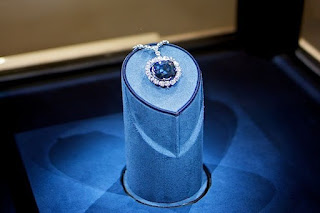THE INFAMOUS HOPE DIAMOND
Kohinoor isn't the only diamond from India that had stirred the world. The Hope diamond seems to be the exact opposite of its name.
Objects have power, whether real or appearing to be real. It is widely accepted that the more precious an object, the more powerful it appears to become. Some objects even carry with themselves an aura of mystery.
One such object is the Hope diamond, which brought very bad luck to whoever owned it. It was mined in the famous Golconda diamond mines in India, although the exact date for this is not known. What is known is that it appeared in Europe in 1642, after it was bought by the French traveler Jean-Baptiste Tavernier. In 1668, he sold it to King Louis XIV for a large amount of money, but lost the fortune because he had to pay off his son's debts. Tavernier returned to India to recover his fortune, but was mauled to death by dogs.
King Louis XIV, the Sun King, almost from the moment he had the diamond, started losing his empire and his popularity. Princess de Lamballe, who got it from the king, was beaten to death.
The next owner, Louis XVI and Queen Marie Antoinette were guillotined. The diamond passed into the hands of the new French Republic.
Years later, a Dutch diamond cutter reduced the size of the diamond, but not its supposed curse. His son stole it from him and the unhappy cutter committed suicide. In 1830, the diamond got its name after being bought by the banker Henry Hope. One of his descendants, Lord Francis Hope, went nearly bankrupt when he was forced to sell it, and his wife blamed the diamond for the failure of their marriage.
The new owner, Jacques Colot, committed suicide, and the two following owners were murdered. In 1908 it was bought by a Turkish sultan, who stabbed his wife shortly afterwards and was overthrown. Edward McLean, who bought it next, suffered from numerous runs of simple bad luck.
Harry Winston, who bought it from McLean, was the only man who escaped these strings of bad events too numerous to be dismissed as mere coincidence. Some say he did it because he donated it for free to the Smithsonian Institution, where you can see it today.
One such object is the Hope diamond, which brought very bad luck to whoever owned it. It was mined in the famous Golconda diamond mines in India, although the exact date for this is not known. What is known is that it appeared in Europe in 1642, after it was bought by the French traveler Jean-Baptiste Tavernier. In 1668, he sold it to King Louis XIV for a large amount of money, but lost the fortune because he had to pay off his son's debts. Tavernier returned to India to recover his fortune, but was mauled to death by dogs.
King Louis XIV, the Sun King, almost from the moment he had the diamond, started losing his empire and his popularity. Princess de Lamballe, who got it from the king, was beaten to death.
The next owner, Louis XVI and Queen Marie Antoinette were guillotined. The diamond passed into the hands of the new French Republic.
Years later, a Dutch diamond cutter reduced the size of the diamond, but not its supposed curse. His son stole it from him and the unhappy cutter committed suicide. In 1830, the diamond got its name after being bought by the banker Henry Hope. One of his descendants, Lord Francis Hope, went nearly bankrupt when he was forced to sell it, and his wife blamed the diamond for the failure of their marriage.
The new owner, Jacques Colot, committed suicide, and the two following owners were murdered. In 1908 it was bought by a Turkish sultan, who stabbed his wife shortly afterwards and was overthrown. Edward McLean, who bought it next, suffered from numerous runs of simple bad luck.
Harry Winston, who bought it from McLean, was the only man who escaped these strings of bad events too numerous to be dismissed as mere coincidence. Some say he did it because he donated it for free to the Smithsonian Institution, where you can see it today.





Comments
Post a Comment